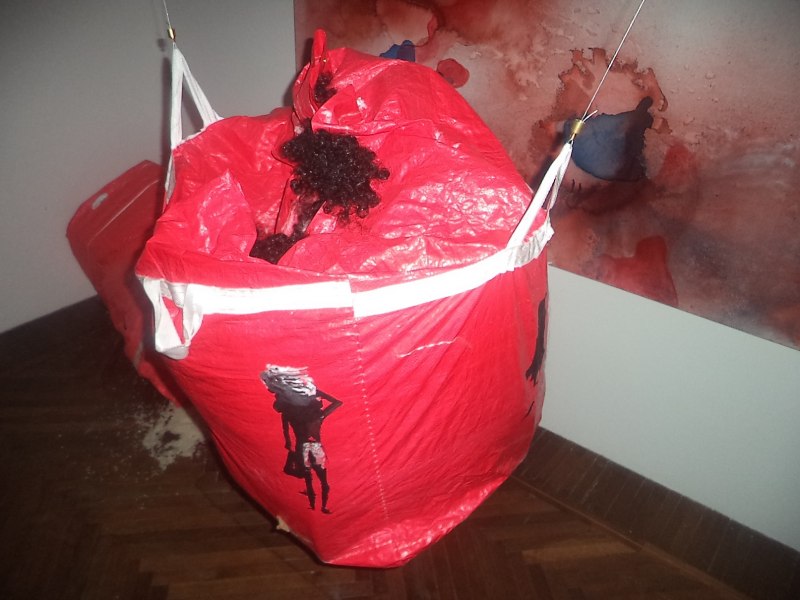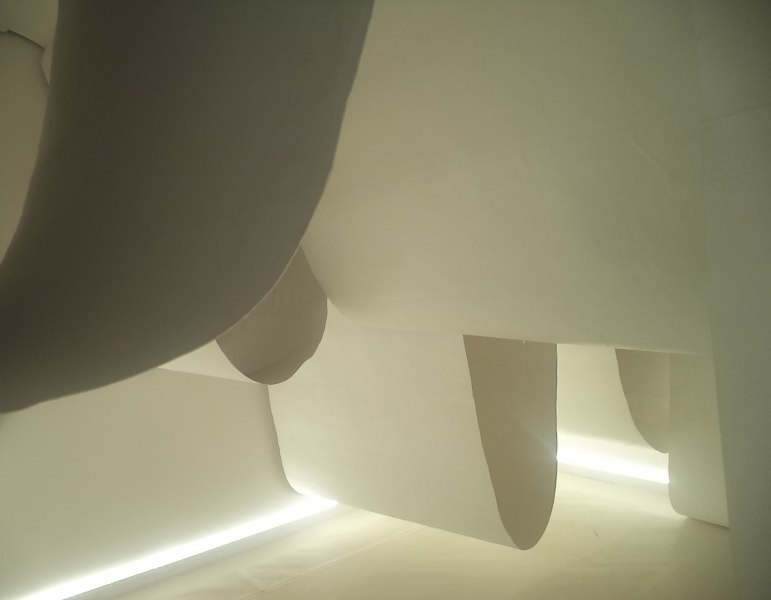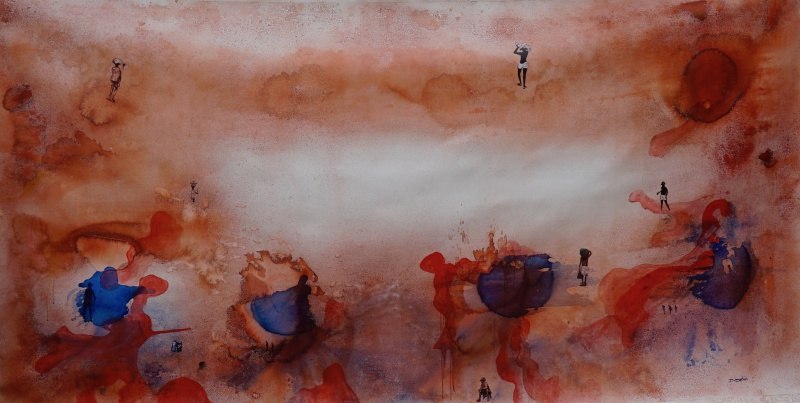Alla Biennale di Venezia, era visitabile il Padiglione Nazionale delle Seychelles, allestito presso il Palazzo Mora. In esso, gli artisti George Camille e Daniel Dodin avevano indagato il tema dell’autodeterminazione, in risposta sia all’informazione sia al mercato. Tale binomio sembra geograficamente applicabile alle Seychelles, che per noi “varrebbero” dalla pubblicità al turismo. Un paradiso esotico dialetticamente s’autodetermina come “tutto da scoprire”. E’ un luogo talmente incontaminato che forse perderà il problema della sua verità. Qualcosa che si viva… e basta, come modernamente ci “suggerisce” il turismo. La pubblicità va sempre percepita tramite “l’arrotondamento per eccesso” dell’informazione. Così “si svicola” sull’autodeterminazione subliminale del mercato. Le Seychelles geograficamente consentono un “arrotondamento” dalla povertà africana al benessere esotico. Ma quale sarà la verità della vita umana? L’artista George Camille esibisce un “bombardamento” informativo, e fasciando la visita della sua stanza. Facendo un paragone sinestetico, le onde non si fanno mai “sfogliare”… L’esotico è turisticamente “tutto da catalogare”. Qualcosa che avrebbe il suo contraltare nella povertà d’un recuperante, per l’artista Daniel Dodin. Egli installa e dipinge il sacco. Può capitare che i poveri tentino di rivendere i rifiuti in plastica o metallo. Evidentemente, il riciclo si percepirà “arrotondando” solo per difetto.
Per Roland Barthes, Jules Verne avrebbe adoperato l’immaginazione del viaggio per esplorare la chiusura. Almeno in epoca contemporanea, lo spirito d’avventura è stato rimpiazzato dalla comodità del turismo. I libri di Jules Verne mostrano che nulla può sfuggire agli ideali borghesi. Approdati all’isola deserta, e dei propri sogni, comunque ci rilasseremo in pantofole, con la pipa all’angolo del fuoco (mentre fuori la tempesta oscura quanto la giungla).
George Camille esibisce l’installazione dal titolo Drift. Uno tsunami di carta bianca pende dal soffitto, sino a “scavare” il pavimento. Secondo la comunicazione, ogni scoop necessita di “sdraiarsi” sulla propria veridicità. Nell’installazione dell’artista, tendiamo a percepire una certa “stanchezza”. L’eccesso d’informazioni, che spesso si contraddicono, sembra volutamente altalenante per “spremere” l’ansia dei lettori. C’è anche il paradosso che si discuta “a vanvera”, ma senza combinare nulla. George Camille esporrebbe una carta da parati più “munta” che sfogliabile. Quando un evento accade improvvisamente, coinvolgendo l’intera società, ciascuno tende ad affannarsi per dare la sua opinione. Qualcosa che il divulgatore di fake news calibrerà astutamente. Così l’installazione dell’artista diventa più “ingrassata” dall’altalena di verificazioni che “sdraiata” all’essenzialità d’un aggiornamento. Quando andiamo in vacanza, soprattutto nei luoghi esotici noi vogliamo “staccare la spina”. La quotidianità del lavoro nemmeno ci disturba. Conseguentemente, leggiamo i meri dispacci sugli eventi in madrepatria. George Camille mette il rotolo di carta in “mungitura” quasi “pantofolaia”. Ma è davvero possibile estraniarsi completamente dagli eventi del mondo? La carta dell’artista ha una serie di rilievi, ed in accordo col simbolismo del tipografico. Il disegno complessivo prevede che i pesci, le noci di cocco e le foglie tropicali si facciano costantemente afferrare dalle braccia umane. Se il turista vuole estraniarsi, ciò non impedisce che gli indigeni reclamino un po’ d’attenzione, sui loro problemi.
A Venezia, l’artista Daniel Dodin espone il dipinto dal titolo Miserable joy. Gli indigeni appaiono radi, in lontananza e rimpiccioliti. Essenzialmente loro trasportano qualcosa, usando i sacchi. Il quadro fa sbattere il blu sul rosso, quasi riconfigurando la “falena” d’una circolazione sanguigna. Il calore tropicale rimarrebbe al buio d’un ondeggiamento “puramente venoso”. In mezzo al quadro, più chiaramente c’è una nebulosa. Gli indigeni trasportano nascostamente il “sangue” per la vivacità del turista. Ma quanto la “bandiera blu” della spiaggia ingrasserebbe l’economia locale, se l’albergatore fosse un occidentale? Sappiamo che le farfalle vivono poco. Il turismo avviene di massa, concentrato in specifici periodi dell’anno. Quello determina un aumento dei rifiuti, cosicché Daniel Dodin ci esibisce pure le “sacche rosse” d’una sabbia rivitalizzata per plastificazione. Ovvio è qualcosa che gli ambientalisti respingeranno… L’artista ne approfitta, per ricordarci quegli indigeni che “vivacchiano” saccheggiando la spazzatura. Sembra che una plastica nera ed infestante “strizzi” la sabbia, sino all’esplosione. Nel dipinto denominato Miserable joy, la “valvola cardiaca” d’un blu all’acqua cristallina faticherà a resistere, contro la nebulosa stagnante. Posti al ciglio del sacco, i “globuli neri” infesterebbero il laccio bianco dell’ondeggiamento al vento. Il risultato è una rovinosa caduta. Si “stacca la spina” fra il consumo ed il riciclo, forse ad ammonirci che il turismo di massa rischia di deturpare la verginità dei paesi esotici. Anche Daniel Dodin usa il titolo Drift, per i suoi sacchi.
Recensione estetica per il Padiglione Nazionale delle Seychelles – Biennale di Venezia 2019
THE REUSE OF THE TOURISM
BETWEEN DRIFTING AND ROUNDING DOWN
At the Venice Biennale 2019, the National Pavilion of Seychelles was visitable, in staging at the Palazzo Mora. There, the artists George Camille and Daniel Dodin investigated the theme of the self-determination, in response both to the information and the market. That couple seems geographically applied to Seychelles, which “would assume a value” for us from the advertisement to the tourism. An exotic paradise dialectically is in the self-determination “all to be discovered”. That is a place so uncontaminated that maybe it will lose the problem of its truth. Something that we have only... to live, as in a modern way the tourism “suggests” us. The advertising has always to be perceived through a “rounding up” of the information. So “we twist and turn” on the subliminal self-determination of the market. The Seychelles geographically allows a “rounding” from the African poverty to the exotic wellness. But what will be the truth of the human life? The artist George Camille shows an informative “bombardment”, and bandaging the visit of his room. Making a synesthetic comparison, the waves don’t allow to “be browsed”… The exotic is touristically “all to be catalogued”. Something that would have its counterbalance in the poverty of a salvager, according to the artist Daniel Dodin. He installs and paints the sack. Sometimes happens that poor men try to resell the garbage in plastic or metal. Evidently, the reuse will be perceived “rounding” only down.
According to Roland Barthes, Jules Verne uses the imagination of a travel to explore a closure. At least in the contemporary age, the spirit of adventure was replaced by the comfort of tourism. The books of Jules Verne show that nothing can escape from ideals of middle class. Arriving at a desert island, where we can realize our dream, however we will relax through the slippers, and the pipe at the fireside (while outside a storm darkens exactly like the jungle).
George Camille shows the installation called Drift. A tsunami of white paper is hanging from the ceiling, until it digs the floor. According to the communication, every scoop needs to “lie down” on the own veracity. In the installation of the artist, we tend to perceive a sort of “tiredness”. The excess of information, that are often contradictory, seems intentionally seesawing to “squeeze” the anxiety of the readers. There is also the paradox for which we discuss “nonsense”, but not able to do anything right. George Camille would expose a wallpaper more “milked” than browsed. When an event happens suddenly, involving the entire society, everybody tends to work so hard to give an own opinion. Something that a propagator of fake news will shrewdly calibrate. So the installation of the artist becomes more “fattened” from the seesaw of the verifications than “lying down” at the essential nature of an updating. When we go on holiday, principally in the exotic places we want to “blow off some steam”. The everyday life at work neither disturbs us. Consequently, we read the mere dispatches about the events in our homeland. George Camille puts the roll of paper in a “milking” almost “couch potato”. But are we really able to become completely estranged from the events in the world? The paper of the artist has a series of reliefs, and in accordance with the symbolism of a typography. The total drawing provides for the fish, the coconuts and the tropical leaves in their constant catching by the human arms. If a tourist wants to become estranged, this situation does not impede the complaint of the indigenous people, for a bit of attention about their problems.
In Venice, artist Daniel Dodin exposes the painting called Miserable joy. The indigenous people appear sparse, in the distance and made smaller. Essentially, they transport something, using the sacks. The picture allows the blue to slam the red, almost reconfiguring the “moth” of a blood circulation. The tropical warmth would remain in the dark of a fluctuation “purely venous”. In the middle of the picture, more clearly there is a nebula. The indigenous people transport secretly the “blood” for the vivacity of a tourist. But how much would the “blue flag” of the beach fatten the local economy, if the hotelier was occidental? We know that the butterflies live for few days. The tourism happens in massification, focused in precise periods of the year. That one determines an increase of the garbage, so Daniel Dodin shows for us also the “red bags” of a sand revitalized through a plastification. Of course that situation will be rejected by the environmentalists… The artist takes advantage from them, to remember us the indigenous people who “stumble along” with the ransacked garbage. It seems that a black and infesting plastic “wrings out” the sand, until its explosion. In the painting called Miserable joy, the “heart valve” of a blue in the crystalline water will struggle to resist, against the stagnant nebula. Placed at the edge of the sack, the “black blood cells” would infest the white lace for a fluctuation in the wind. The result is a massive fall. Between the consumption and the reuse, there is a situation to “blow off some steam”, perhaps to admonish us that the massification of tourism risks marring the virginity of the exotic countries. Also Daniel Dodin uses the title Drift, for his sacks.
Aesthetics review for the National Pavilion of Seychelles – Venice Biennale 2019






